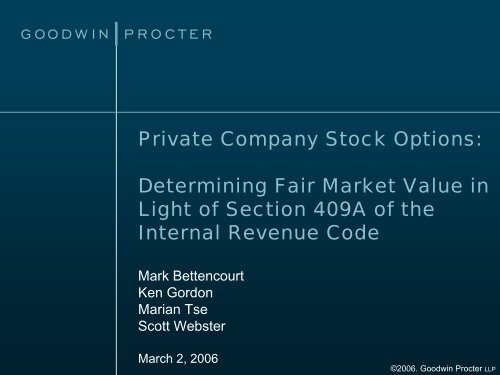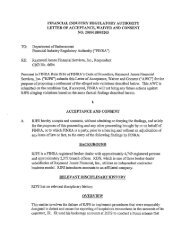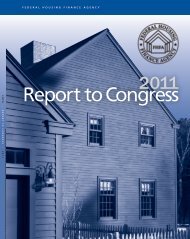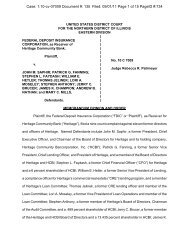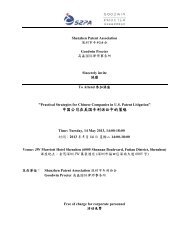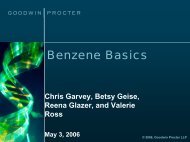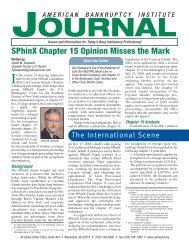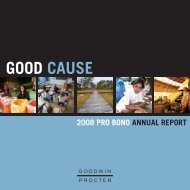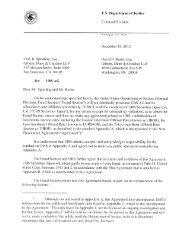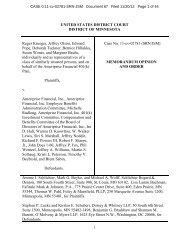Private Company Stock Options: Determining Fair Market Value in ...
Private Company Stock Options: Determining Fair Market Value in ...
Private Company Stock Options: Determining Fair Market Value in ...
You also want an ePaper? Increase the reach of your titles
YUMPU automatically turns print PDFs into web optimized ePapers that Google loves.
<strong>Private</strong> <strong>Company</strong> <strong>Stock</strong> <strong>Options</strong>:<br />
<strong>Determ<strong>in</strong><strong>in</strong>g</strong> <strong>Fair</strong> <strong>Market</strong> <strong>Value</strong> <strong>in</strong><br />
Light of Section 409A of the<br />
Internal Revenue Code<br />
Mark Bettencourt<br />
Ken Gordon<br />
Marian Tse<br />
Scott Webster<br />
March 2, 2006<br />
©2006. Goodw<strong>in</strong> Procter LLP
Agenda<br />
• Discussion of the Law<br />
• Valuations – Quasi Safe Harbors<br />
• Case Studies<br />
• Other Considerations Relat<strong>in</strong>g to Option<br />
Grants<br />
• Best Practices<br />
2
The Law<br />
• American Jobs Creation Act of 2004<br />
created Section 409A of the Internal<br />
Revenue Code<br />
• IRS Guidance<br />
– Notice 2005-1 on December 20, 2004<br />
– Proposed Regulations on September 29, 2005<br />
– Notice 2006-4 on December 28, 2005<br />
– F<strong>in</strong>al Regulations expected this summer to be<br />
effective January 1, 2007<br />
3
The Law<br />
• Broadly applies to all types of nonqualified<br />
deferred compensation<br />
arrangements (e.g., discounted options,<br />
supplemental retirement plans, restricted<br />
stock units, phantom stock, certa<strong>in</strong><br />
severance payments)<br />
• Covers arrangements with employees,<br />
directors, consultants and other service<br />
providers<br />
4
The Law<br />
• 409A penalizes:<br />
– Discounted options<br />
– <strong>Options</strong> with a deferral feature<br />
– <strong>Options</strong> to acquire preferred stock<br />
5
The Law<br />
• Covers options granted after<br />
December 31, 2004 or modified after<br />
October 3, 2004<br />
• Covers options granted before<br />
January 1, 2005 to the extent vest<strong>in</strong>g<br />
occurs after December 31, 2004<br />
6
The Law<br />
• Penalty for non-compliance <strong>in</strong>cludes<br />
taxation at vest<strong>in</strong>g, plus a 20%<br />
additional tax<br />
• For discounted options, spread is taxed<br />
(plus the additional 20% tax) at vest<strong>in</strong>g<br />
and any <strong>in</strong>cremental value is taxed<br />
annually thereafter until exercised<br />
7
The Law<br />
• For example, option granted at $2 when<br />
FMV is $3<br />
• At vest<strong>in</strong>g, FMV is $7<br />
• Under Section 409A, the spread of $5 is<br />
taxed at ord<strong>in</strong>ary <strong>in</strong>come rates (a tax of<br />
$2 at 40% rate) on the vest<strong>in</strong>g date<br />
• Plus an additional 20% tax on the<br />
spread of $5 (or $1)<br />
8
Valuation Methods<br />
• To qualify for the exemption from 409A,<br />
the exercise price per share must not be<br />
lower than the FMV of the underly<strong>in</strong>g<br />
stock at grant<br />
• <strong>Options</strong> granted before January 1, 2005<br />
are exempt from 409A if FMV was<br />
determ<strong>in</strong>ed <strong>in</strong> good faith<br />
9
Valuation Methods<br />
• For options granted after December 31,<br />
2004, FMV can be determ<strong>in</strong>ed us<strong>in</strong>g any<br />
reasonable valuation method under Notice<br />
2005-1 or us<strong>in</strong>g the reasonable application<br />
of a reasonable valuation method under<br />
the proposed regulations<br />
• FMV means a value determ<strong>in</strong>ed by the<br />
reasonable application of a reasonable<br />
method that takes <strong>in</strong>to account all relevant<br />
circumstances<br />
10
Valuation Methods<br />
• Factors to consider:<br />
1. The value of tangible and <strong>in</strong>tangible assets;<br />
2. The present value of future cash flows;<br />
3. The fair market value of stock of companies<br />
engaged <strong>in</strong> substantially similar trades or<br />
bus<strong>in</strong>esses that can be determ<strong>in</strong>ed by objective<br />
means;<br />
4. Control premiums or discounts for lack of<br />
marketability; and<br />
5. Whether the valuation method is used for other<br />
purposes that have a material economic effect on<br />
the company, its stockholders or creditors.<br />
11
Valuation Methods<br />
• A valuation method is not considered<br />
reasonable if it:<br />
– is more than 12 months old;<br />
– does not take <strong>in</strong>to account all available<br />
<strong>in</strong>formation material to the determ<strong>in</strong>ation of value<br />
as of the valuation date; or<br />
– fails to take <strong>in</strong>to account subsequent events such<br />
as the resolution of material litigation or the<br />
issuance of a patent.<br />
12
Valuation “Quasi” Safe<br />
Harbor<br />
• The proposed regulations provide a<br />
“quasi” safe harbor <strong>in</strong> the consistent use<br />
of one of the follow<strong>in</strong>g methods:<br />
– Independent appraiser<br />
– Written report for illiquid stock of start-up<br />
corporation<br />
13
Valuation “Quasi” Safe Harbor<br />
• Valuation determ<strong>in</strong>ed by an <strong>in</strong>dependent<br />
appraiser<br />
– Cannot be more than 12 months old<br />
– Must satisfy certa<strong>in</strong> tax requirements<br />
14
Valuation “Quasi” Safe Harbor<br />
• Valuation of an “illiquid start-up<br />
corporation”<br />
– Corporation must be <strong>in</strong> bus<strong>in</strong>ess for less than 10<br />
years, cannot have publicly-traded equity, and<br />
stock must not be subject to any put or call right<br />
– Must be made reasonably and <strong>in</strong> good faith by a<br />
person or persons with significant knowledge and<br />
experience or tra<strong>in</strong><strong>in</strong>g <strong>in</strong> perform<strong>in</strong>g such<br />
valuations<br />
– Must be evidenced by a written report<br />
15
Valuation “Quasi” Safe Harbor<br />
• Valuation of an “illiquid start-up<br />
corporation” (cont’d.)<br />
– Must take <strong>in</strong>to account all relevant factors,<br />
<strong>in</strong>clud<strong>in</strong>g those described above<br />
– Presumption not available if the corporation<br />
reasonably anticipates at the time of the<br />
valuation that the corporation will undergo a<br />
change-<strong>in</strong>-control event or an IPO <strong>in</strong> the next<br />
12 months<br />
16
Case Study<br />
• Emerg<strong>in</strong>g technology company with two<br />
preferred rounds completed<br />
• <strong>Company</strong> <strong>in</strong> existence for 5 years<br />
• Board of directors <strong>in</strong>cludes CEO, two<br />
VC fund representatives, and two<br />
<strong>in</strong>dustry experts<br />
• Historically options granted to new<br />
employees on the date of hire and to all<br />
employees twice each year<br />
17
Option Grant Profile<br />
• Historical options<br />
– <strong>Options</strong> granted before January 1, 2005<br />
• good faith determ<strong>in</strong>ation<br />
– <strong>Options</strong> granted January 1, 2005 through<br />
December 31, 2006<br />
• reasonable application of a reasonable<br />
valuation method<br />
18
Scenario 1<br />
• IPO likely <strong>in</strong> 2006 or 2007<br />
– <strong>Company</strong> should seriously consider obta<strong>in</strong><strong>in</strong>g<br />
<strong>in</strong>dependent appraisal to manage Section 409A<br />
and SEC “cheap stock” concerns<br />
19
Scenario 2<br />
• Sale event likely <strong>in</strong> 2006 or 2007<br />
– <strong>Company</strong> should strongly consider obta<strong>in</strong><strong>in</strong>g<br />
<strong>in</strong>dependent appraisal to manage Section 409A<br />
concerns<br />
20
Scenario 3<br />
• Neither IPO nor sale event likely <strong>in</strong> 2006<br />
or 2007<br />
– Can use any reasonable method<br />
– Consider use of written report quasi safe harbor<br />
21
Modifications and Extensions<br />
• Any modification of an “<strong>in</strong>-the-money”<br />
option, other than an extension of term,<br />
is treated as new grant<br />
• If option term is extended, the option is<br />
treated as hav<strong>in</strong>g a deferral from the<br />
date of grant<br />
22
Modifications and Extensions<br />
• Modification<br />
– Any change <strong>in</strong> option that may provide optionee<br />
with<br />
• direct or <strong>in</strong>direct reduction <strong>in</strong> stock price<br />
• an additional deferral feature<br />
• an extended exercise period<br />
23
Modifications and Extensions<br />
• Examples of changes that are not<br />
considered modifications:<br />
– Shorten<strong>in</strong>g exercise period<br />
– Accelerat<strong>in</strong>g vest<strong>in</strong>g<br />
– Add<strong>in</strong>g right to tender shares towards exercise<br />
price<br />
– Adjustment to reflect stock split or stock dividend<br />
– Substitutions and assumptions <strong>in</strong> corporate<br />
transactions<br />
24
Modifications and Extensions<br />
• Extensions<br />
– Exercise period is extended<br />
–Notan extension if exercise period is extended to<br />
a date no later than the later of:<br />
• the 15 th day of the third month at which, or<br />
• December 31 of the calendar year <strong>in</strong> which,<br />
the option would have otherwise expired<br />
25
Modifications and Extensions<br />
• Rescission<br />
– Modification can be resc<strong>in</strong>ded if done before the<br />
earlier of the end of calendar year or date of<br />
option exercise<br />
– Example:<br />
• Option amended on March 1 to extend<br />
exercise period by two years<br />
• Resc<strong>in</strong>d extension before year-end and before<br />
option exercise<br />
• Not a modification<br />
26
Remedial Measures<br />
• Alternative 1<br />
– Re-price discounted options to FMV on orig<strong>in</strong>al<br />
grant date before December 31, 2006<br />
– Compensate optionee with cash bonuses<br />
– Cash bonuses must be subject to vest<strong>in</strong>g and<br />
may be tied to option vest<strong>in</strong>g schedule<br />
– Cash bonus may not be paid before 2007<br />
• Alternative 2<br />
– Fix option exercise date<br />
27
Account<strong>in</strong>g Considerations<br />
• AICPA Practice Aid<br />
– Valuation of <strong>Private</strong>ly-Held-<strong>Company</strong> Equity<br />
Securities Issued as Compensation<br />
– Includes three valuation methodologies:<br />
• market-based<br />
• <strong>in</strong>come-based<br />
• asset-based<br />
28
Account<strong>in</strong>g Considerations<br />
• AICPA Practice Aid (cont’d.)<br />
– Ranks preferred methods:<br />
• Contemporaneous <strong>in</strong>dependent appraisal<br />
• Retrospective <strong>in</strong>dependent appraisal<br />
• Contemporaneous or retrospective “relatedparty”<br />
valuation<br />
– Pre-IPO companies should consider the AICPA<br />
Practice Aid<br />
29
Best Practices<br />
• Consider likelihood and tim<strong>in</strong>g of IPO or<br />
sale event<br />
• Adopt valuation method, either appraisal<br />
or written report<br />
• Apply valuation method consistently<br />
• Reduce frequency of grants and vest<strong>in</strong>g<br />
dates<br />
• Be careful of modifications<br />
• Consider <strong>in</strong>creased use of restricted stock<br />
30
GOODWIN PROCTER LLP<br />
Boston<br />
Exchange Place<br />
Boston, Massachusetts 02109<br />
(617) 570-1000<br />
New York<br />
599 Lex<strong>in</strong>gton Avenue<br />
New York, New York 10022<br />
(212) 813-8800<br />
Wash<strong>in</strong>gton, DC<br />
901 New York Avenue, NW<br />
Wash<strong>in</strong>gton, DC 20001<br />
(202) 346-4000<br />
www.goodw<strong>in</strong>procter.com<br />
31
GOODWIN PROCTER LLP<br />
Mark Bettencourt – mbettencourt@goodw<strong>in</strong>procter.com<br />
Ken Gordon – kgordon@goodw<strong>in</strong>procter.com<br />
Marian Tse – mtse@goodw<strong>in</strong>procter.com<br />
Scott Webster – swebster@goodw<strong>in</strong>procter.com<br />
32


